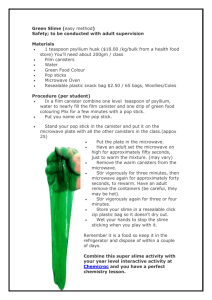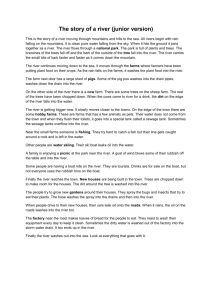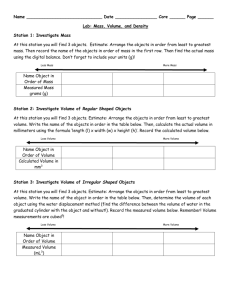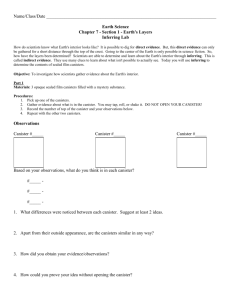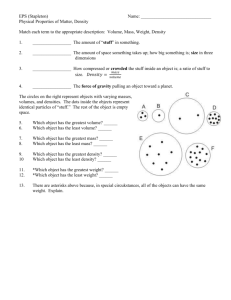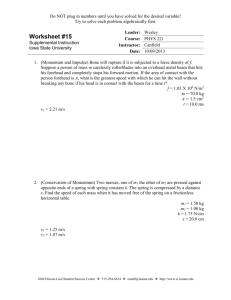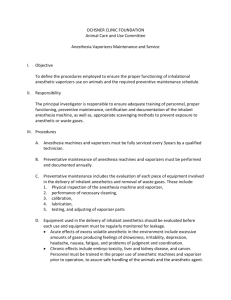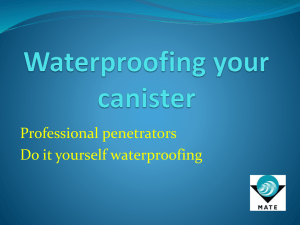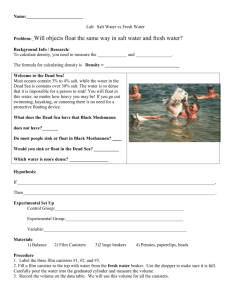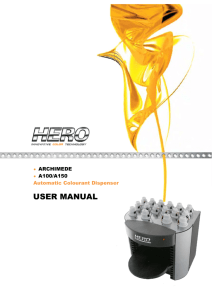WhoTrashedtheTN
advertisement
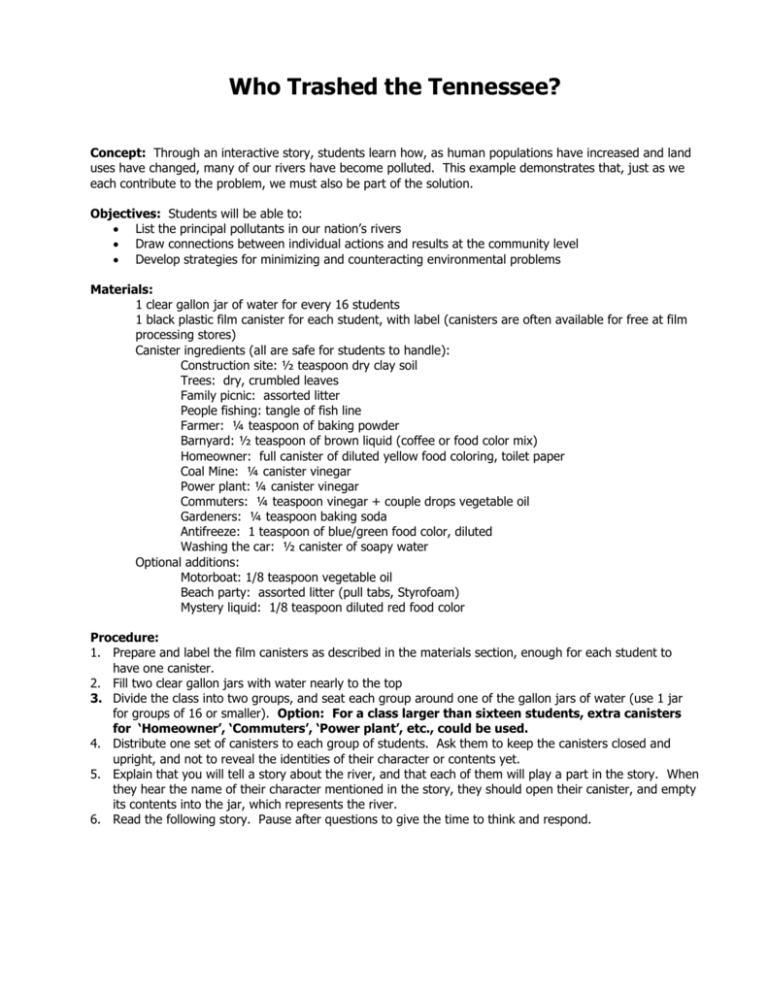
Who Trashed the Tennessee? Concept: Through an interactive story, students learn how, as human populations have increased and land uses have changed, many of our rivers have become polluted. This example demonstrates that, just as we each contribute to the problem, we must also be part of the solution. Objectives: Students will be able to: List the principal pollutants in our nation’s rivers Draw connections between individual actions and results at the community level Develop strategies for minimizing and counteracting environmental problems Materials: 1 clear gallon jar of water for every 16 students 1 black plastic film canister for each student, with label (canisters are often available for free at film processing stores) Canister ingredients (all are safe for students to handle): Construction site: ½ teaspoon dry clay soil Trees: dry, crumbled leaves Family picnic: assorted litter People fishing: tangle of fish line Farmer: ¼ teaspoon of baking powder Barnyard: ½ teaspoon of brown liquid (coffee or food color mix) Homeowner: full canister of diluted yellow food coloring, toilet paper Coal Mine: ¼ canister vinegar Power plant: ¼ canister vinegar Commuters: ¼ teaspoon vinegar + couple drops vegetable oil Gardeners: ¼ teaspoon baking soda Antifreeze: 1 teaspoon of blue/green food color, diluted Washing the car: ½ canister of soapy water Optional additions: Motorboat: 1/8 teaspoon vegetable oil Beach party: assorted litter (pull tabs, Styrofoam) Mystery liquid: 1/8 teaspoon diluted red food color Procedure: 1. Prepare and label the film canisters as described in the materials section, enough for each student to have one canister. 2. Fill two clear gallon jars with water nearly to the top 3. Divide the class into two groups, and seat each group around one of the gallon jars of water (use 1 jar for groups of 16 or smaller). Option: For a class larger than sixteen students, extra canisters for ‘Homeowner’, ‘Commuters’, ‘Power plant’, etc., could be used. 4. Distribute one set of canisters to each group of students. Ask them to keep the canisters closed and upright, and not to reveal the identities of their character or contents yet. 5. Explain that you will tell a story about the river, and that each of them will play a part in the story. When they hear the name of their character mentioned in the story, they should open their canister, and empty its contents into the jar, which represents the river. 6. Read the following story. Pause after questions to give the time to think and respond. WHO TRASHED THE TENNESSEE? For many thousands of years, people have lived on the banks of the Tennessee River. They hunted in the forests, harvested foods from wetlands, and caught fish in the river. Question: Imagine that the jar of water in front of you was taken from the Tennessee River by a Native American about 500 years ago. Describe how it looks to you. Would you drink this water? Eat fish that came from it? Swim in it? When European colonists began to arrive, they found fertile land for farming, forests teeming with wildlife, and a river that provided ample food and water. It was an outstanding environment for settlement, and the colonists prospered. How do you think the colonists used the river? Do we use the river the same way today? The river has changed a lot since it was first explored. This is the story of those changes. Listen for the name of the character printed on your canister. When you hear your character named, open the canister and dump its contents into the river. Years went by, and occasional storms drenched the area. High winds whipped through the trees and blew leaves into the water. Gradually, the cities grew up on the banks of the river. Developers cleared wetlands and forests to build houses and businesses. Rains washed loose soil from construction sites into the river. Is this water safe to drink? (If the response is “no,” ask if the river had leaves or soil in it when explorers first drank from it.) Would you swim in it? Is it safe for wildlife? At first, the cities were small. Upstream, farmers planted crops to feed the cities’ growing population. Some of these crops grew right up against the banks of the river, and fertilizer washed off the land and into the water. Other farmers kept pigs and other animals in their barnyards. As rainwater drained out of the barnyards, it carried some of the manure into little creeks behind the farms. The creeks flow into the river. Would you drink this water now? Would you swim in it? Go boating in it? Is it safe for wildlife? As the cities grew, more and more people began to move to the nearby countryside. These rural houses are not connected to the city sewer systems. Waste water from these houses flows into the septic tanks under the ground. One homeowner has not maintained the septic tank, and poorly treated sewage seeps into the river. To meet the electricity needs of the cities, area officials decided that they would need to generate more power. Far upstream, a coal mine was dug. Rain water drained down into the mine shaft and soaked the piles of wastes and scraps from mining. This made the rainwater become acidic—sort of like a strong vinegar. Then the acid water trickled back out into the river. To burn the coal and produce the power, electric power plants were built along the river. Gases coming out of the smokestacks combine with moisture in the air to form acids. The pollution falls back to earth as acid rain or smog. Would you drink this water now? Would you swim in it? Go boating? Could fish or other wildlife live in water that was like vinegar? As the cities continue to grow along the Tennessee River, traffic congestion is a big problem for commuters who drive their cars to and from work. Car exhaust fumes (just like power plan fumes) cause acid rain. If a car is not kept in good repair, it might also leak oil or other fluids, which will be washed off the pavement and into the river with the next rain. And how do the residents of the cities and suburbs spend their time? In one neighborhood, lots of gardeners are out working in their yards. Many of them are using weed killers and insect sprays to keep their lawns attractive. The next rain will wash these poisons into a little creek nearby, and then into the river. One father is teaching his daughter how to change the antifreeze in their truck. They pour out the used antifreeze into the driveway. Antifreeze is sweet-tasting and can poison animals that lick it. It can also get into the nearby creek and poison fish. Nearby, a boy washed the family car. The soapy water rushes down the driveway into a storm drain; the storm drain empties into the river. The grease and grime on a car contain asphalt from the roads, asbestos from the brakes, rubber particles from the tires, toxic metals, and rust. If the boy had gone to a local car wash, the water would have been treated before it returned to the river. Optional: Next door, a family is cleaning out their garage. They find an old rusty can with a tattered ‘skull and crossbones’ label still stuck on it. What could it be? It looks dangerous and they want to get rid of it before someone gets hurt. But how? Junior gets an idea: “Let’s pour it down the drain out by the curb!” So the mysterious liquid goes down the storm drain. The poison is out of sight---but is headed for the river. On nice days, many people head down to the river. Optional: Some zoom up and down the river in motorboats and don’t notice that a little engine oil leaks into the water. Optional: A group of friends have spread blankets on the shore for a beach party. Lots of families are picnicking in the parks, too. Some of these people have left trash on the shore. With the next storm, that trash will wash into the river. On the shore, a person fishing snags a hook on a log, and breaks off the nylon fishing line. Discussion Questions: Who trashed the Tennessee? (everyone played a role.) What effect did the increasing population have on the health of the river? (More people meant less wetlands which filter water, more cars, less open space, etc.) Can you think of any ways that population increases helped the river? (Higher population densities led to more efficient use of resources, stronger environmental laws, public resources like sewage treatment plants, etc.) Can you come up with ways to clean up the water in the jar; after all, everything has to go SOMEWHERE! (Solids could be strained out, filtered, use of absorbent cotton might be helpful.) Once this type of pollution has entered the river, how can we get it out? How can we clean up the river? Do you think it is easier to prevent pollution, or to clean up later? (Have them explain their ideas.) What could each of us do to help improve the health of our river by preventing some of this pollution? (possible answers include biking or walking instead of driving, conserving water, picking up litter, pulling weeds instead of spraying them, etc. Follow-up: Although this activity conveys the story of the Tennessee River, similar situations exist in many watersheds throughout the country. You may wish to use the story of the Tennessee as an example for comparison with your local river or lake, or you may want to adapt the story to fit special concerns within your local watershed. Acknowledgement: This activity was adapted from “Who Polluted the Potomac,” from the Teachers’ PET (Population Education Training) Project, Zero Population Growth, Inc., and was originally developed by Hard Bargain Farm Environmental Center, Accokeek, MD.
